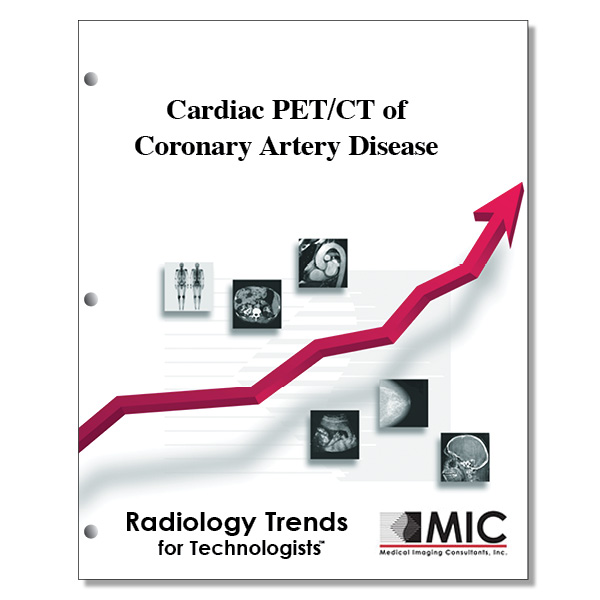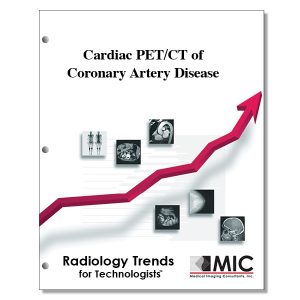

Cardiac PET/CT of Coronary Artery Disease
An overview of PET in the evaluation of myocardial perfusion and how hybrid PET/CT scanners allow anatomic characterization of the coronary arteries.
Course ID: Q00344 Category: Radiology Trends for Technologists Modalities: Cardiac Interventional, CT, Nuclear Cardiology, Nuclear Medicine, PET3.5 |
Satisfaction Guarantee |
$37.00
- Targeted CE
- Outline
- Objectives
Targeted CE per ARRT’s Discipline, Category, and Subcategory classification:
[Note: Discipline-specific Targeted CE credits may be less than the total Category A credits approved for this course.]
Cardiac-Interventional Radiography: 1.50
Procedures: 1.50
Diagnostic and Conduction System Studies: 1.50
Computed Tomography: 1.50
Procedures: 1.50
Neck and Chest: 1.50
Nuclear Medicine Technology: 3.00
Procedures: 3.00
Cardiac Procedures: 3.00
Registered Radiologist Assistant: 2.00
Procedures: 2.00
Thoracic Section: 2.00
Outline
- Introduction
- Technical Aspect of Myocardial Perfusion PET
- Advantages of PET
- Imaging Agents for Clinical Use
- Advances in PET Technology
- Optimized Protocols for Myocardial Perfusion Imaging
- Radiation Dosimetry
- Recognizing and Preventing Imaging Artifacts at Cardiac PET/CT
- Diagnostic and Prognostic Performance of Myocardial Perfusion PET
- Comparison with SPECT
- Detection of Multivessel CAD
- Quantification of Left Ventricular Function
- Quantification of Myocardial Blood Flow and Flow Reserve
- Risk Prediction
- Improvement of Risk Stratification with CFR Estimates
- Emerging Clinical Role of Integrated PET/CT
- Potential Added Value of CAC Score in Patients with Normal Myocardial Perfusion
- Potential Added Value of Coronary CT Angiography in Patients with Equivocal Myocardial Perfusion PET Findings
- Potential Added Value of Myocardial Perfusion PET in Patients with Apparent CAD at Coronary CT Angiography
- Customization of Protocols
- Conclusions
Objectives
Upon completion of this course, students will:
- identify the advantages of PET cardiac imaging over SPECT cardiac imaging
- be familiar with the particles detected in PET image creation
- know the advantages and disadvantages of Rubidium 82 for PET MPI
- know the advantages and disadvantages of Nitrogen 13 Ammonia for PET MPI
- know the currently reported advantages and disadvantages of 18F flurpiridaz for PET MPI
- be familiar with recent PET hardware and software improvements over prior generation PET systems
- be familiar with the phenomenon known as “cardiac creep” and how it can affect MPI
- understand the benefits of list mode PET imaging
- know the different CT acquisition options for a PET attenuation correction CT series
- be familiar with the acquisition times for PET MPI imaging
- know the prep medications for CT angiography and the reasons for their usage
- be familiar with the properties of cardiac stress agents
- be familiar with the contraindications of cardiac stress agents
- be familiar with the patient dose comparison among various PET and SPECT MPI studies
- know causes for PET MPI artifacts due to CT transmission and PET emission misalignment
- be familiar with the PET MPI accuracy statistics the article cites
- define false positive for MPI
- be familiar with the major causes of false positive and false negative results of MPI exams
- be familiar with sensitivity, specificity, accuracy, and positive and negative predictive values
- be familiar with the accuracy of PET MPI versus SPECT MPI
- recognize the manifestations of balanced coronary ischemia
- be familiar with normal LVEF stress response compared to abnormal LVEF stress response
- understand the relationship between angiographic CAD and stress-induced LVEF change
- know the method(s) utilized in PET assessment of multi-vessel CAD
- know the relationship between PET coronary vasodilator reserve estimates and stenosis severity
- understand PET MPI quantitation limitations and exams that may help in these situations
- understand the implications of increasing extent and severity of PET MPI perfusion defects
- understand how an increase in stress perfusion defects’ severity affects mortality prediction
- recognize the prognostic information relationship between LVEF and stress MPI
- know what determines patient pre-MPI likelihood of CAD
- know at what pretest disease probability diagnostic examinations are most useful
- understand the value of CFR estimation in patients with known or suspected CAD
- be familiar with the factors incorporated into the Framingham scoring system
- know the limitations of the Framingham scoring system
- be familiar with the benefits of integrated PET/CT for cardiac imaging
- understand the rationale for including CT CAC scoring with PET MPI
- know the possible benefits of integrated PET/CT assessment of MPI and CAC scoring
- know the HU groups for the Agatston method of calcium scoring
- understand the drawbacks of Agatston calcium scoring
- be familiar with the factors that confound the link between impaired CFR and obstructive epicardial disease
- know how CTA can increase the specificity and PPV of PET CFR measurements
- be familiar with treatment regimens for epicardial stenosis and impaired microvascular function
- be familiar with the limitations of coronary CTA and how PET MPI can complement this exam
- know the benefits of PET MPI as an adjunct exam to coronary CTA
- be familiar with the considerations of creating different cardiac assessment protocols
